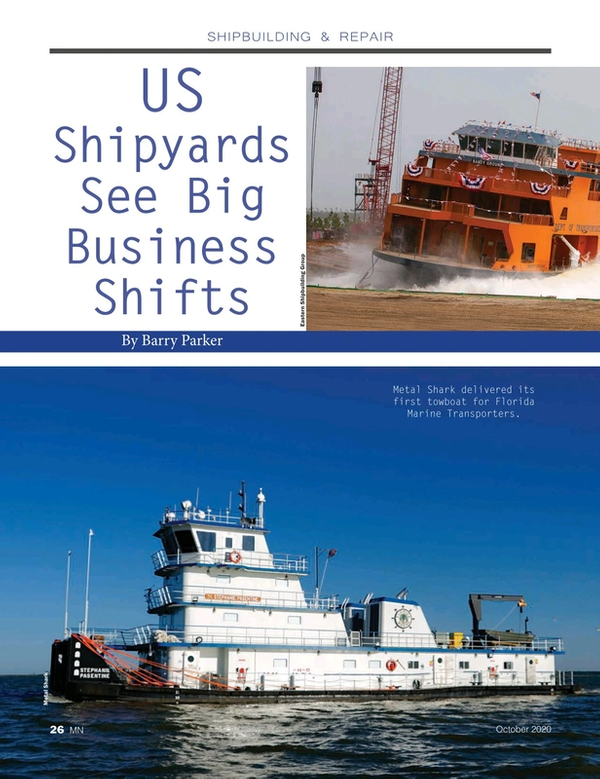
US Shipyards See Big Business Shifts
The American shipbuilding scene, filled with participants constructing all manner of vessels, has been navigating through stormy times (lately, yards along the Gulf Coast have literally been dealing with storms). The orders for newbuild, repair and conversion projects continue to flow in—albeit at a reduced pace—and the boats and ships go down the ways into the water, but the overall panorama has seen tremendous sea changes as the business has shifted.
Maritime businesses worldwide have been grappling with currents both internal and external. Across the entire landscape in 2020, the COVID-19 pandemic has brought about operational changes that will continue into the future, long after Americans are vaccinated. Most U.S. shipyards were identified early on as “essential businesses”, and therefore continued working throughout 2020. The proactive attitude of one yard during 2020’s pandemic did not go unnoticed, with Fincantieri Bay Shipbuilding (FBS) receiving the Northeast Wisconsin Service Award. As explained in a press release from FBS, “The award honors the unsung heroes of the coronavirus who helped keep Wisconsin moving while the state was shut down. Honorees are selected for going above and beyond the call of duty in their respective fields or industries.”
Throughout the maritime world, again reflecting broader trends, talk has turned to “decarbonization” (with reduced CO2 going beyond notions of simply improving vessel efficiency), which will have profound implications for vessel propulsion and fuel choices. Initially, this trend has driven a movement toward liquefied natural gas (LNG) fueled propulsion. In Pascagoula, Miss., the Halter Marine yard will soon be completing the tug barge combination Q-Ocean Service / Q-LNG 4000, for Q-LNG. The 4,000 cubic meter unit will be contracted to Shell, and will be handling both ship-to-ship and ship-to-shore transfers of LNG to vessels and to shoreside LNG distribution depots.
 Tug barge combination Q-Ocean Service / Q-LNG 4000 at Halter Marine (Photo: Q-LNG)
Tug barge combination Q-Ocean Service / Q-LNG 4000 at Halter Marine (Photo: Q-LNG)
Indicative of the currents, FBS, in Sturgeon Bay, Wis., held a modern day “keel laying ceremony” (with pre-constructed modules laid in place), in late June, for an LNG bunker barge, Clean Canaveral, that will provide fuel to shipping customers of NorthStar Midstream (tied to private investor Oaktree Capital), along the U.S. East Coast, out of Jacksonville. The 5,400 cubic meter articulated tug barge (ATB) unit will be owned by a new entity, Polaris New Energy, which has options on two additional units.
With its Great Lakes location, FBS is also building a 28,000 dwt. self unloading bulk carrier for Interlake Steamship, and delivered the dry bulk barge Michigan Trader to Van Enkevort Tug and Barge in August.
Along the Gulf Coast, Eastern Shipbuilding- Panama City, Fla. has also been active in multiple segments. The yard is in the midst of a three-vessel order for New York City’s Staten Island Ferry. The first of the 4,500-passenger trio, Sgt Michael Ollis, is set to be delivered in late 2020 (after being delayed due to Hurricane Michael in 2018), with a second vessel, Sandy Ground, launched in June 2020. The yard has continued to work, in the midst of the pandemic and an active hurricane season. In August, Eastern, which had previously been a prodigious producer of tugboats, delivered the 5,100 hp Z-drive ship-handling tug A. Thomas Higgins to E.N. Bisso (following up on a sister vessel C.D. White delivered earlier in the year).
Also in the Gulf, the Metal Shark facilities, encompassing three locations in Louisiana and Alabama, have been active, with a varied construction slate. The Bayou La Batre, Ala. facility (previously the Horizon Shipyard) recently delivered a 6,000-horsepower boat to Florida Marine Transporters (FMT), the first of a three boat order, and the yard’s first towboat for the inland marketplace. The Metal Shark yards have also continued to deliver ferries to NYC Ferry (in New York) and to Potomac Water Taxi, in the Washington, D.C. area. Metal Shark, also a prolific builder of fast boats for law enforcement and for military users, credits “series production” to its ability to deliver vessels rapidly and at scale, at a time that cities such as New York seek to move commuters from automobiles onto ferries.
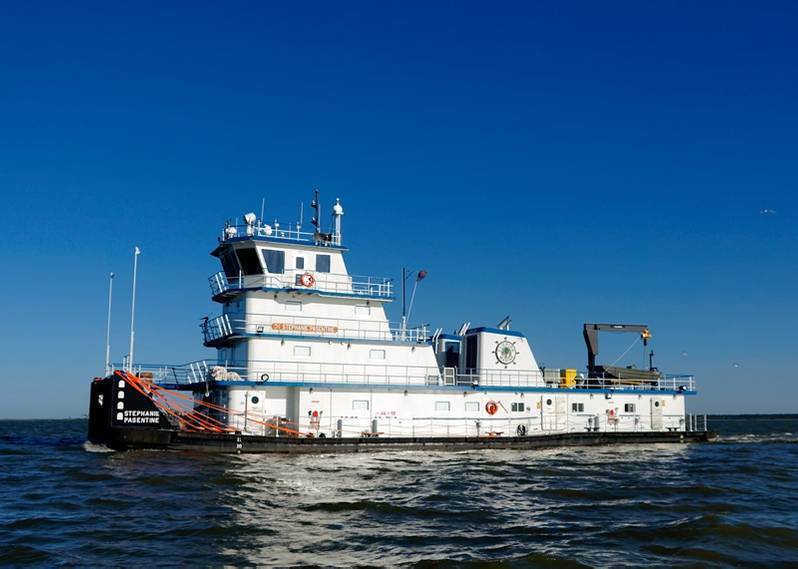
A different sort of environmental theme (against a backdrop of increased funding for dredging) is evidenced most recently with Eastern Shipbuilding beginning construction on a second new 8,550-cubic-yard trailing suction hopper dredge for Weeks Marine Inc. (with a previous unit delivered in 2017). Elsewhere, Conrad Shipyard is building a 6,500-cubic-yard TSHD for Great Lakes Dredge & Dock Corporation. And the Keppel AmFELS yard at Brownsville, Texas announced an order for a 15,000-cubic-yard hopper dredge, to be delivered in 2023 to Manson Construction. The yard (historically a builder of jack-up rigs) is also constructing two LNG-fueled containerships that will be deployed by Pasha Hawaii in the Jones Act trades from the West Coast.
On the West Coast, General Dynamics’ NASSCO, in San Diego (which, like the Philly Shipyard on the East Coast, had earlier successes in delivering multi-vessel series of Jones Act suitable double hulled tankers as the pre-OPA fleet was being phased out), delivered Lurline, the first of two 3,500 TEU container vessels to Matson, which also boast a 500 vehicle garage capacity. A second vessel, Matsonia, is expected to be delivered in late 2020. The vessels, readily upgradable for LNG fueling in the future, will serve in the line’s West Coast- Hawaii trades.
With oil price wars and trade wars, economists can argue about whether we are in a “slowdown” or a “recession”. However, weak demand on the commercial side (energy and also agricultural) has seen a counterbalance from the government side. The Philly Shipyard has chosen to pivot from commercial to government work- with the contract award emphasizing a need to infuse commercial best-practices. The Philly Shipyard, which had completed a pair of container vessels for Matson, is now set to begin construction, initially, of two training ships destined for maritime academies (with the first going to Fort Schuyler- State University of New York). The newbuilds, with Tote Inc managing the actual contracting and construction process for the U.S. Maritime Administration, will go way beyond their role in training maritime cadets. As National Security Multi-Mission Vessels, their capabilities will enable them to respond to natural disasters, and provide humanitarian aid. The vessels, set to join the National Defense Reserve Fleet, will have ro-ro capabilities (for heavy equipment) and extensive berthing capacity. NASSCO, with no additional deepsea commercial orders announced, is putting its tanker expertise to work, building a series of fleet oilers for the U.S. Navy. Halter Marine is also constructing vessels for the Coast Guard and the Navy, and Eastern is building the Coast Guard’s first offshore patrol cutters.
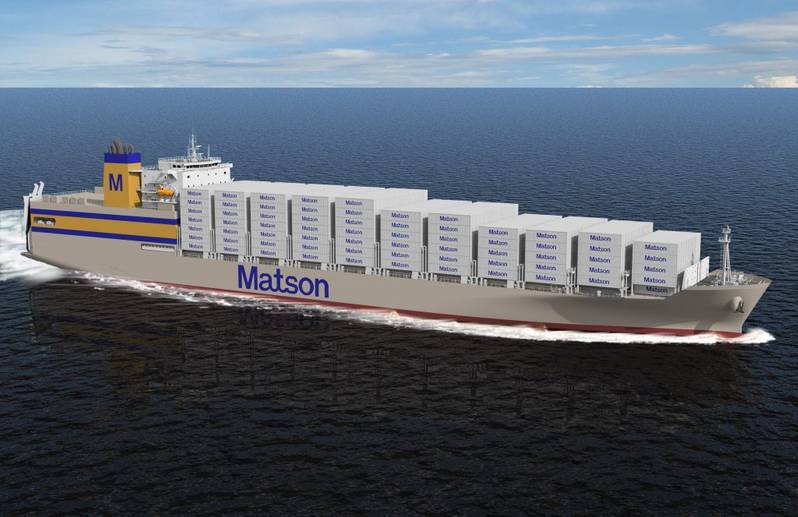 NASSCO is building Matson's latest ConRo shps (Image: Matson)
NASSCO is building Matson's latest ConRo shps (Image: Matson)
Bollinger’s Lockport, La. yard scored a big win in late September with a U.S. Coast Guard awarding a newbuild contract, with four fast response cutters to be delivered during 2022 and 2023. The group also recently received an order for a floating drydock that will service U.S. Navy submarines at General Dynamics Electric Boat yard at Groton, Conn. Austal, another yard with commercial work in its past at its Mobile, Ala. yard (the old Bender facility), has delivered a fast transport ship to the U.S. Navy, with multiple transports also under construction. Like other yards, it has benefited from government work, in this case, with a specialty in troop transports and landing vessels.
The sustainability trend looms large. In the not too distant future, additional U.S. built vessels will be needed to serve offshore wind energy projects. The rumor mill is whirring about numerous discussions said to be underway between project developers and U.S. owners regarding installation vessels. Matt Tremblay, ABS Senior Vice President, Global Offshore, told Marine News, “ABS is involved in a range of projects to support the development of the U.S. offshore wind industry, including providing services to vessels destined to be constructed in U.S. shipyards.” He added, “As the industry and the turbines continue to grow in size and complexity, the vessels needed to install them in U.S. waters will need to be built, and we are seeing increased demand for increasingly specialized vessels. ABS is involved in advanced discussions with key players on the development of further Jones Act vessels which will be key to the development of the U.S. industry.”
Tremblay explained further, “At the end of 2019 ABS granted VARD the first Approval in Principle (AIP) for a Jones Act service operations vessel (SOV), with primary functions including accommodation, transferring technicians to installations as well as storing spare parts and tools for operations in U.S. offshore wind farms. That milestone has been followed by further AIPs both to VARD for a large SOV and to BAR and Chartwell Marine for an innovative Jones Act crew transfer vessel.”
Tremblay pointed to the class society’s prominent role in wind energy’s buildout, evolving analogously to offshore oil drilling towards floating units. “ABS provides leading classification services for wind support vessels, including self-elevating units, wind turbine installations vessels and offshore support vessels. ABS classed the largest wind farm installation jack-up Seajacks Scylla in 2015 and earlier this year, to the first floating heavy lift installation vessel to be built in Taiwan, Green Jade. ABS is also a world leader in classing floating offshore wind, in process of classing nearly 80 megawatts of floating wind.”
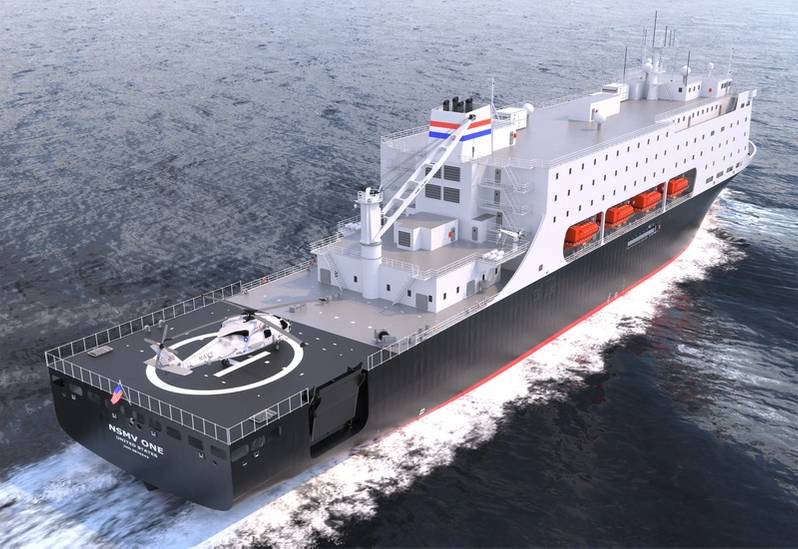 The new maritime academy training ships will be built at Philly Shipyard (Image: MARAD)
The new maritime academy training ships will be built at Philly Shipyard (Image: MARAD)
Choosing a Yard: One Customer’s Perspective
Vane Brothers, a leading participant in coastal and harbor movements of petroleum products and ship bunkering, has been a major customer of U.S. yards. Capt. Jim Demske, who is in charge of newbuild construction at the Baltimore based vessel owner, explained his criteria for sizing up a potential builder of new equipment for Vane. He explained, “Among many considerations, I want to know the yard’s reputation for constructing the type of tug required by Vane Brothers. I need to be certain they can build the design to our specifications, deliver it in a timely manner, and bring it in at our budgeted cost.”
Recent Vane newbuilds have included three Assateague class ATBs (built at Conrad Shipyards with 4,400 bhp tugs coupled to 80,000 bbl barges) and two Salisbury class push boats (3,000 bhp), suitable for the inland rivers. Two more of the push boats are under construction, at Chesapeake Shipbuilding (which has also carved out a niche in building small river cruise vessels for American Cruise Lines).
Capt. Demsky continued, “If the yard has been building tugs for many years, there is a good chance I have been aboard some of their tugs or designs. I would already have a good idea of what I like about their builds, their strengths and weaknesses, and what the yard can provide to ensure that new Vane vessels maximize safety, performance and crew comfort.”
Vane Brothers takes a hands-on approach, with Capt. Demsky telling Marine News, “I like to walk the yard and talk with management and supervisors to get a feel for the knowledge and expertise they offer. The rapport we are able to build is always important, since I will be interacting with yard personnel on a nearly daily basis for the length of the project. During the walk, I also look to see whether the yard is well kept and efficiently laid out. If the yard is clean and organized, I feel better about entrusting them with a Vane Brothers project.”
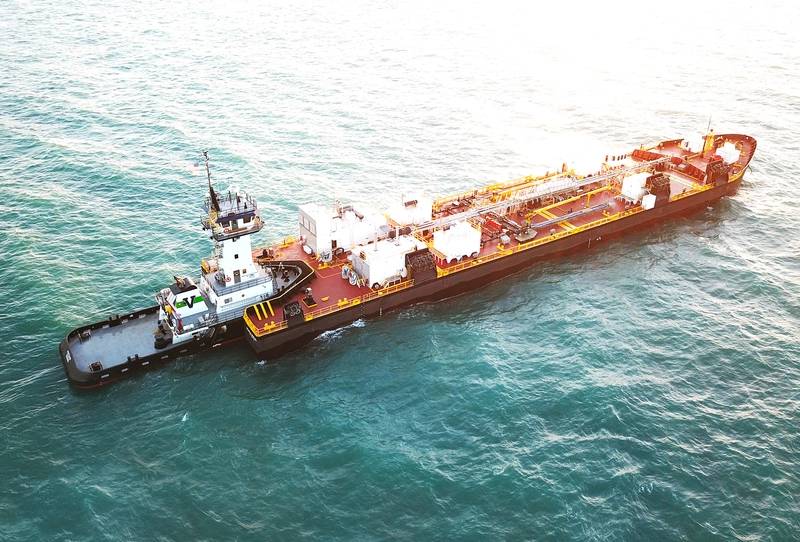 (Photo: Vane Broters)
(Photo: Vane Broters)
Read US Shipyards See Big Business Shifts in Pdf, Flash or Html5 edition of October 2020 Marine News
Other stories from October 2020 issue
Content
- Interview: Bob Merchent, CEO, Halter Marine page: 11
- Bridge Heights Are Not Guesswork: Accuracy Is Imperative page: 20
- Reverse Osmosis and the New Dawn of Marine Desalination page: 22
- Working Out the Election’s Impact on the US Workboat Industry page: 22
- US Shipyards See Big Business Shifts page: 26
- US Shipyards: Always on the Job Hunt page: 34
- How is COVID-19 Influencing Passenger Vessel Design? page: 40
- Naval Fuel-related Assets Protected by Coatings and New Robust Standards page: 42
- New Towboat Gets a Complete Thordon Propulsion Package page: 44
- Tech File: oneTank Ballast Water Treatment System page: 47
- Tech File: BioBarrier MarineMBR page: 49

